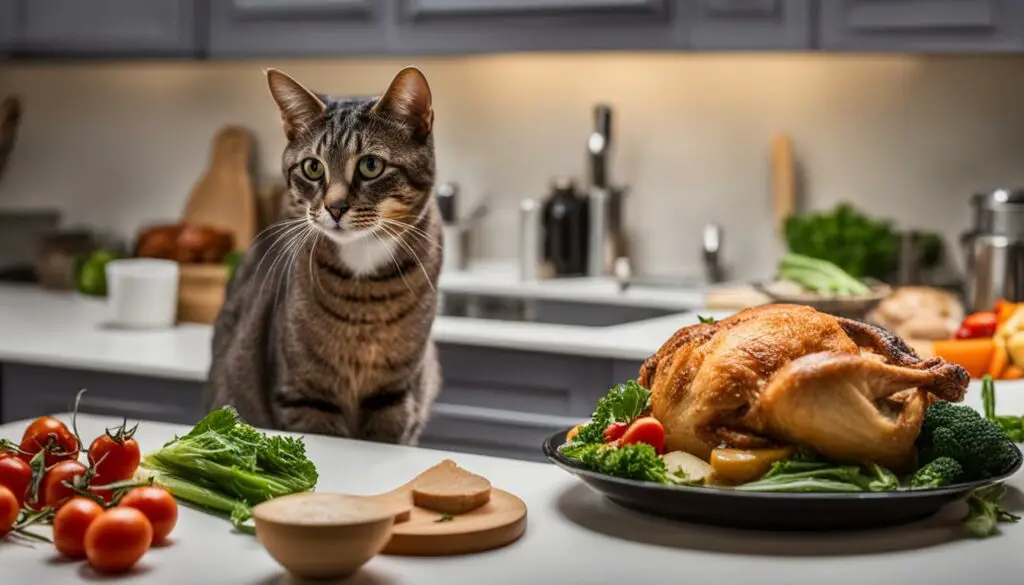As a cat owner, I’m sure you’ve wondered whether it’s safe to feed your furry friend chicken breast. We all want to provide our cats with the best nutrition, but it’s important to understand the benefits and risks associated with this particular food. In this article, I will explore the topic of cats and chicken breast, discussing both the pros and cons to help you make an informed decision.
When it comes to feeding cats, there is a lot of debate surrounding the topic of raw diets. Some argue that it mimics a cat’s natural diet, while others raise concerns about safety. Let’s delve deeper into the world of cats and chicken breast to discover the truth.
Key Takeaways:
- Feeding cats chicken breast can provide a high-quality source of lean protein.
- Chicken breast contains essential amino acids, such as taurine, which are important for a cat’s health.
- It’s crucial to handle and prepare chicken breast safely to minimize the risk of bacterial contamination.
- Consulting with a veterinarian is always recommended before making any significant changes to your cat’s diet.
- Chicken bones, whether cooked or raw, should never be given to cats as they can pose a choking hazard.
The Pros of Feeding Cats Chicken Breast
Feeding cats chicken breast can have several benefits. Firstly, it provides a high-quality source of lean protein, which is essential for a cat’s overall health and well-being. Chicken breast also contains amino acids, such as taurine, which are crucial for normal heart function, vision, and reproduction in cats. Additionally, chicken breast is highly palatable for most cats, making it an appealing food option.
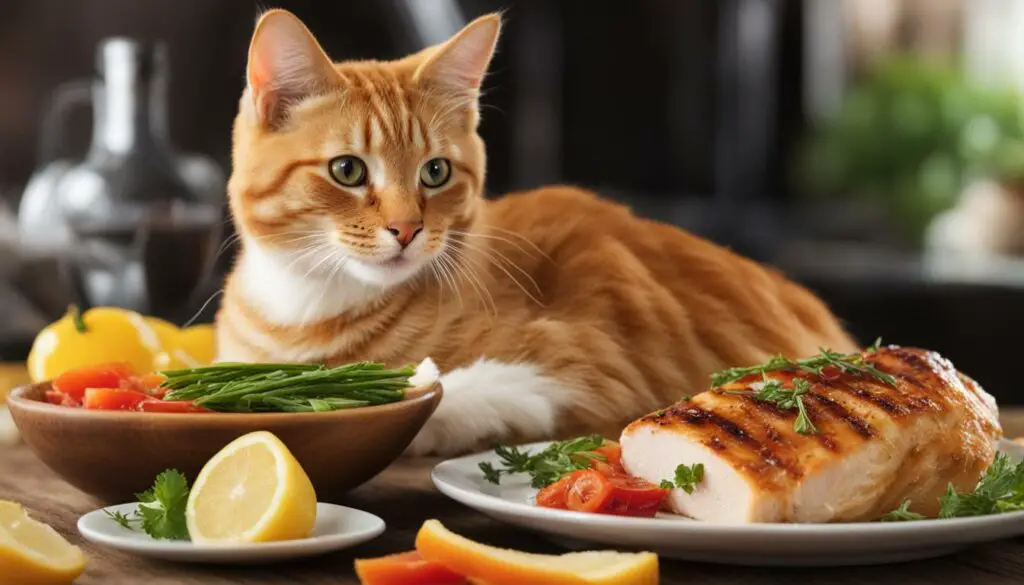
“Chicken breast is a great source of lean protein for cats, providing them with the essential amino acids they need for optimal health. It’s a highly digestible and palatable option that many cats enjoy. Just be sure to remove any skin or bones before serving.”
When feeding cats chicken breast, it’s important to consider their individual dietary needs and consult with a veterinarian for guidance. While chicken breast can be a healthy addition to a cat’s diet, it should not replace a balanced and complete cat food. Cats require a variety of protein sources and a diet that meets their specific nutritional needs. By providing a balanced diet, including chicken breast in moderation, you can help support your cat’s overall health and well-being.
The Risks of Feeding Cats Chicken Breast
Feeding cats chicken breast can provide nutrition and variety to their diet, but it’s important to be aware of the potential risks involved. One of the main concerns is the potential for bacterial contamination. Chicken can harbor bacteria such as Salmonella or E. Coli, which can be harmful to both cats and humans. To reduce the risk of infection, it’s crucial to handle and prepare chicken breast safely.
Some cats may also have allergies or sensitivities to chicken. It’s important to monitor your cat’s reaction when introducing chicken breast to their diet. Look out for signs of digestive upset, itching, or skin irritations. If you notice any adverse reactions, it’s best to consult with a veterinarian.
To further minimize the risks associated with feeding cats chicken breast, it’s recommended to ensure the chicken is fresh and properly cooked. Thoroughly cooking the chicken will help kill any potential bacteria. Avoid using seasonings or spices, as some ingredients can be toxic to cats. It’s also a good practice to cut the chicken into small, digestible pieces to prevent choking hazards.
| Risks of Feeding Cats Chicken Breast | Precautions to Take |
|---|---|
| Bacterial contamination (Salmonella, E. Coli) | – Handle and prepare chicken safely – Cook chicken thoroughly – Avoid using seasonings or spices |
| Allergies or sensitivities | – Monitor cat’s reaction – Look out for signs of digestive upset or skin irritations – Consult a veterinarian if adverse reactions occur |
| – Ensure chicken is fresh – Cut chicken into small, digestible pieces |
Cooking Methods for Feeding Cats Chicken Breast
When it comes to feeding cats chicken breast, it’s important to choose safe and appropriate cooking methods. Properly cooked chicken breast can provide a nutritious and delicious addition to your cat’s diet. Here are some cooking methods to consider:
Boiling
Boiling chicken breast is a simple and effective cooking method. It ensures that the meat is thoroughly cooked and eliminates any potential bacteria or parasites. Simply place the chicken breast in a pot of water and bring it to a boil. Allow it to cook for about 15-20 minutes or until the chicken is fully cooked. Once cooked, remove the chicken from the water and let it cool before serving it to your cat.
Oven-Baking
Oven-baking is another great cooking method for chicken breast. It helps to retain the moisture and tenderness of the meat. Preheat your oven to 375°F (190°C) and place the chicken breast on a baking sheet. Bake for approximately 20-25 minutes or until the chicken is cooked through. Make sure to let the chicken cool before serving it to your cat.
Canned Chicken
If you prefer a convenient option, you can also use canned chicken for your cat. However, it’s important to choose low- or no-sodium options and check the ingredients to ensure there are no additives or preservatives that may be harmful to cats. Simply open the can, drain the liquid, and serve the chicken in small, digestible pieces.
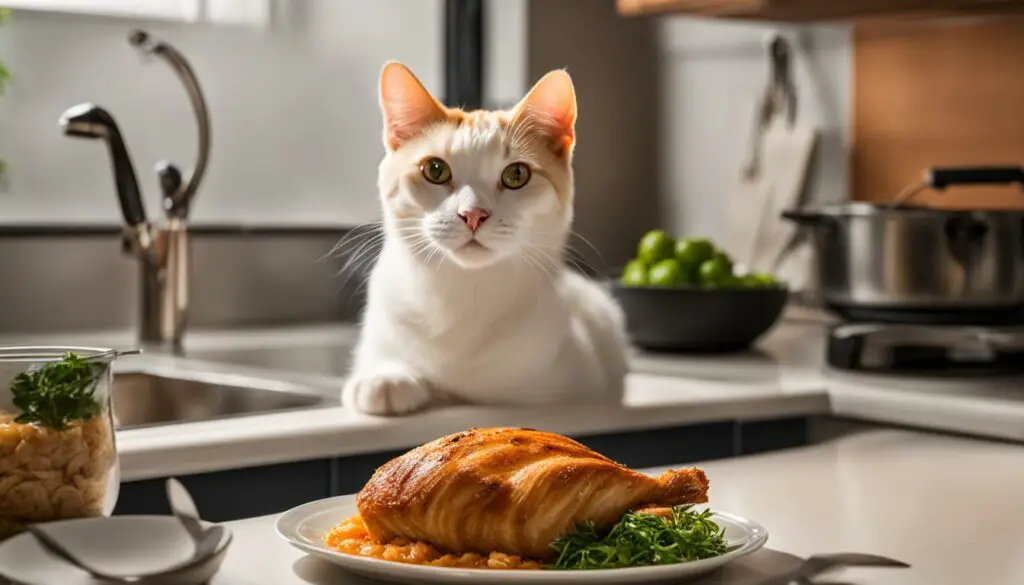
Remember, regardless of the cooking method you choose, it’s essential to remove any seasoning or spices from the chicken before serving it to your cat. Also, always cut the chicken breast into small, bite-sized pieces to make it easier for your cat to eat and digest.
Raw Chicken and Cats – A Controversial Topic
Feeding cats raw chicken is a highly debated topic in the feline community. While advocates argue that it closely resembles a cat’s natural diet and provides optimal nutrition, it’s important to carefully consider the potential risks and precautions associated with feeding raw meat to cats.
Raw chicken may contain bacteria, such as Salmonella or E. Coli, which can pose health risks to both cats and humans. These bacteria can cause food poisoning and serious infections. It is crucial to handle raw chicken properly, ensuring it is stored, prepared, and served safely to minimize the risk of contamination.
Additionally, raw chicken could potentially contain parasites, such as Toxoplasma gondii, which can cause toxoplasmosis in cats. This parasitic infection can lead to a variety of health issues, including flu-like symptoms, respiratory problems, and even neurological disorders.
“Feeding raw chicken to cats should be approached with caution due to the potential risks of bacterial contamination and parasitic infections.”
If you are considering feeding your cat raw chicken, it is crucial to consult with a veterinarian who can provide guidance tailored to your cat’s specific needs. They can offer advice on safe handling practices, appropriate portion sizes, and potential alternatives to ensure your cat’s nutritional needs are met while minimizing risks.
| Risks of Feeding Cats Raw Chicken | Precautions |
|---|---|
| • Bacterial contamination (Salmonella, E. Coli) | • Consult with a veterinarian for guidance |
| • Parasitic infections (Toxoplasma gondii) | • Properly handle, prepare, and store raw chicken |
| • Consider alternative protein sources |
The Importance of Balanced Nutrition for Cats
Feeding cats chicken breast can be a beneficial part of their diet, but it’s important to ensure balanced nutrition. While chicken breast provides a high-quality source of lean protein, it should not be the sole food source. Cats require a variety of nutrients, vitamins, and minerals to thrive. Consulting with a veterinarian and creating a balanced diet plan is essential to meet their specific dietary needs.
“A balanced diet is crucial for cats to ensure they receive all the essential vitamins and minerals they need.”
When considering feeding your cat chicken breast, it’s important to include other protein sources such as fish or turkey. Variety in their diet ensures they receive a broad range of nutrients. Additionally, cats require specific amino acids, such as taurine, which are essential for optimal health. Supplementing their diet with a variety of protein sources helps ensure they receive these necessary nutrients.
“Consulting with a veterinarian can help tailor your cat’s diet to meet their individual needs.”
| Guidelines for Balanced Nutrition for Cats | Benefits |
|---|---|
| Include a variety of protein sources | Provides essential amino acids and nutrients |
| Incorporate carbohydrates in moderation | Source of energy and fiber |
| Ensure a proper balance of fats | Aids in nutrient absorption and energy |
| Provide essential vitamins and minerals | Promotes overall health and well-being |
By following these guidelines and providing a balanced and varied diet for your cat, you can help support their overall health and well-being. Monitoring their response to different foods and consulting with a veterinarian will ensure you are meeting their specific needs. Remember, each cat is unique, and what works for one may not work for another. Providing balanced nutrition is key to keeping your feline friend healthy and happy.

Key Takeaways:
- Feeding cats chicken breast can be beneficial, but should not be the sole food source.
- Consult with a veterinarian to create a balanced diet plan for your cat.
- Incorporate a variety of protein sources and ensure they receive essential nutrients.
- Monitor your cat’s response to different foods and adjust their diet accordingly.
- Providing balanced nutrition is crucial for their overall health and well-being.
Precautions and Safety Measures
When it comes to feeding cats chicken breast, it’s important to take precautions and follow necessary safety measures to ensure the well-being of your feline friend. Here are some essential tips to consider:
Handling and Preparation:
Always use fresh chicken breast and make sure it is properly cooked before feeding it to your cat. This helps minimize the risk of bacterial contamination, such as Salmonella or E. Coli. It’s crucial to handle raw chicken properly and avoid cross-contamination with other surfaces and utensils. Thoroughly wash all surfaces and utensils that come into contact with raw chicken to prevent the spread of bacteria.
Hygiene:
Practice good hygiene by washing your hands before and after handling chicken. This helps prevent the transmission of any potential pathogens to your cat or yourself. Keeping clean and practicing proper hygiene is essential for maintaining the health and safety of both you and your feline companion.
Monitor Your Cat:
Observe your cat closely after introducing chicken breast to their diet. Watch for any adverse reactions, such as vomiting, diarrhea, or changes in behavior. If you notice any concerning signs, consult with your veterinarian for further guidance and assistance.
By following these precautions and safety measures, you can minimize the risk of bacterial contamination and ensure the overall health and well-being of your beloved cat.
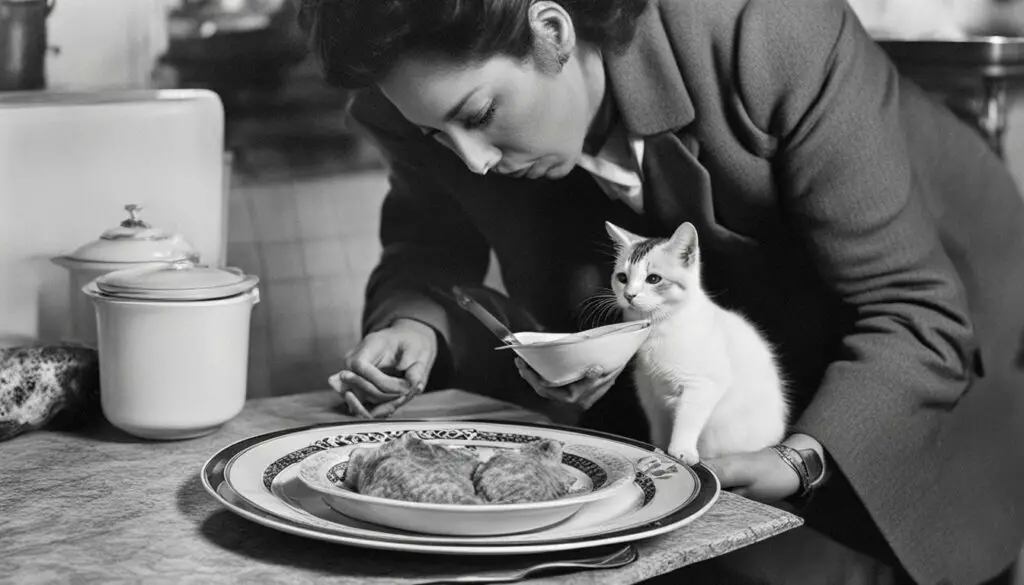
| Precautions | Safety Measures |
|---|---|
| Use fresh chicken breast | Properly cook the chicken |
| Handle raw chicken safely | Wash surfaces and utensils |
| Practice good hygiene | Wash hands before and after handling chicken |
| Monitor your cat closely | Observe for adverse reactions |
Chicken Bones and Cats
When it comes to feeding cats, there is often confusion about whether chicken bones are safe for them to consume. It’s important to note that feeding cats chicken bones, whether cooked or raw, is not recommended. Both types of bones can pose serious health risks to cats and should be avoided altogether.
Why are chicken bones dangerous for cats?
The main concern with chicken bones is their tendency to splinter when chewed. Cooked chicken bones can break into sharp fragments that can cause choking or injury to a cat’s gastrointestinal tract. These splinters can puncture the throat, esophagus, or intestines, leading to severe complications that may require surgical intervention.
Raw chicken bones, on the other hand, can also pose risks for cats. They are more likely to cause constipation and can potentially become lodged in the digestive tract, leading to obstructions or blockages.
It’s important to note that chicken bones do not provide any nutritional benefits for cats. Cats require a balanced diet that includes appropriate sources of protein, fat, and other essential nutrients. Offering them safe and nutritionally complete cat food options is the best way to meet their dietary needs.
| Reasons why chicken bones are dangerous for cats | Why cats should avoid chicken bones |
|---|---|
| 1. Splintering when chewed | 1. Risk of choking or injury to the gastrointestinal tract |
| 2. Possibility of constipation | 2. Potential for obstructions or blockages in the digestive tract |
| 3. Lack of nutritional benefits | 3. Inadequate source of essential nutrients for cats |
Therefore, it’s crucial to keep chicken bones out of reach of cats and ensure that any food scraps containing bones are disposed of safely. If you suspect your cat has consumed chicken bones or shows signs of distress, contact your veterinarian immediately for guidance and assistance.
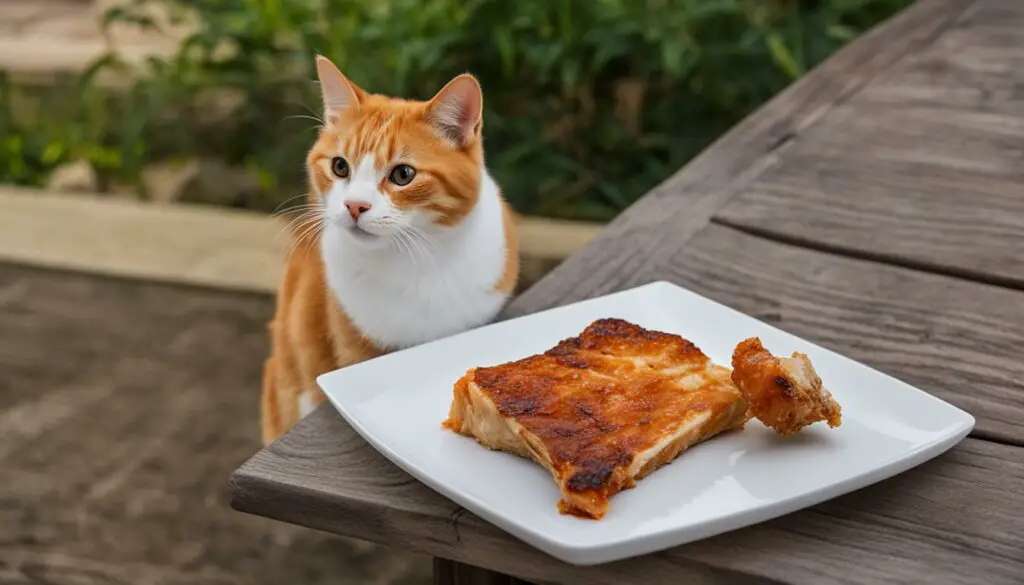
Commercial Cat Food Options
If you prefer not to prepare chicken for your cat at home, there are many commercial cat food options that contain chicken as an ingredient. These cat foods are specially formulated to provide balanced nutrition and meet the specific dietary needs of cats. When choosing a commercial cat food, it’s important to read the labels carefully and select brands that prioritize the nutritional needs of cats.
Look for high-quality cat foods that list chicken as one of the main ingredients. This ensures that your cat is getting a significant amount of lean protein from the chicken. Additionally, check for the inclusion of other essential nutrients such as vitamins, minerals, and taurine.
Some popular brands that offer commercial cat food options with chicken include Royal Canin, Hill’s Science Diet, and Purina Pro Plan. These brands have a wide range of formulas tailored to different life stages, such as kitten, adult, and senior cats. It’s essential to choose a formula that is appropriate for your cat’s age and specific health needs.
| Brand | Product | Features |
|---|---|---|
| Royal Canin | Indoor Adult | – Formulated for indoor cats – Helps maintain a healthy weight – Supports digestive health |
| Hill’s Science Diet | Adult Optimal Care | – Provides balanced nutrition – Promotes a healthy immune system – Supports optimal body weight |
| Purina Pro Plan | True Nature Natural Chicken & Liver | – Grain-free formula – High in protein – Supports a healthy skin and coat |
Points to Consider
- Choose a commercial cat food that is appropriate for your cat’s age and specific health needs.
- Read the labels carefully to ensure the cat food contains high-quality ingredients, including chicken.
- Consider your cat’s preferences and any dietary restrictions when selecting a commercial cat food.
- Consult with your veterinarian for personalized recommendations and guidance on choosing the right commercial cat food for your cat.
Feeding commercial cat food with chicken can provide a convenient and balanced option for cat owners. These cat foods are specifically formulated to meet the nutritional needs of cats, ensuring they receive all the essential nutrients they require for optimal health and well-being.
Remember, it’s important to provide a variety of protein sources in your cat’s diet, so incorporating commercial cat food with chicken alongside other protein options can help ensure a well-rounded and balanced diet. Regular veterinary check-ups are also crucial to monitor your cat’s overall health and make any necessary adjustments to their diet.
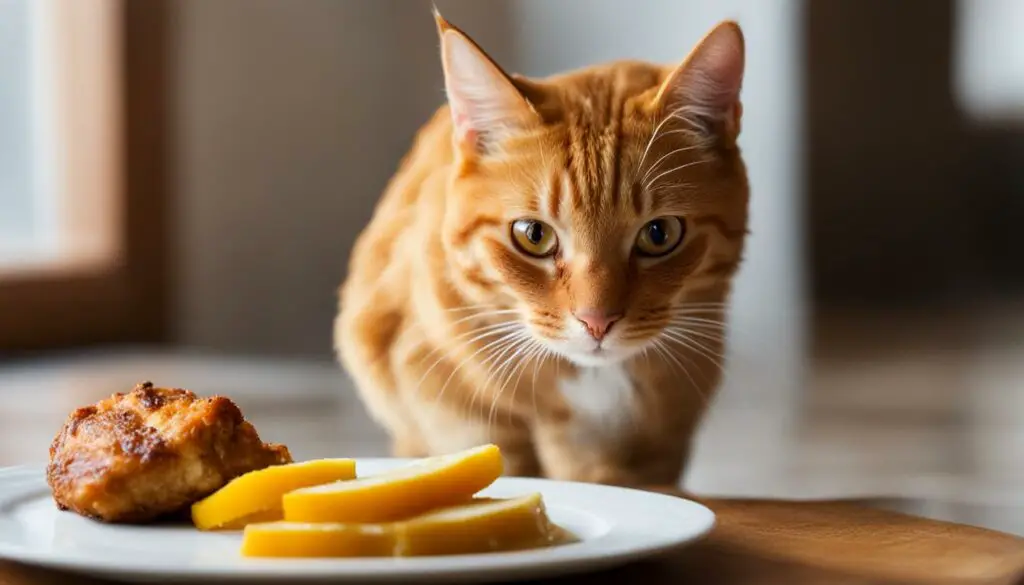
Consulting with a Veterinarian
When it comes to feeding cats chicken breast, it’s always a good idea to consult with a veterinarian. They have the expertise and knowledge to provide personalized recommendations based on your cat’s specific needs and health conditions. Whether you’re considering feeding cooked or raw chicken breast to your cat, a veterinarian can assess if it’s appropriate and safe for them.
A veterinarian can also provide guidance on portion sizes and frequency of feeding. They can help you create a balanced diet plan that includes chicken breast as part of a wider variety of protein sources. By working with a veterinarian, you can ensure that your cat’s nutritional needs are being met and address any concerns or questions you may have about feeding them chicken breast.
Additionally, a veterinarian can monitor your cat’s health and well-being as you introduce chicken breast to their diet. They can help identify any adverse reactions or negative effects. Regular check-ups and communication with a veterinarian are crucial to ensuring that your cat remains healthy and thriving.
Expert Insight
Feeding cats chicken breast can be a healthy addition to their diet when done safely and in moderation. However, it’s important to consult with a veterinarian to ensure that the chicken breast is appropriate for your cat’s individual needs and health conditions. They can provide guidance on the best way to introduce chicken breast and monitor your cat’s overall health and well-being.”
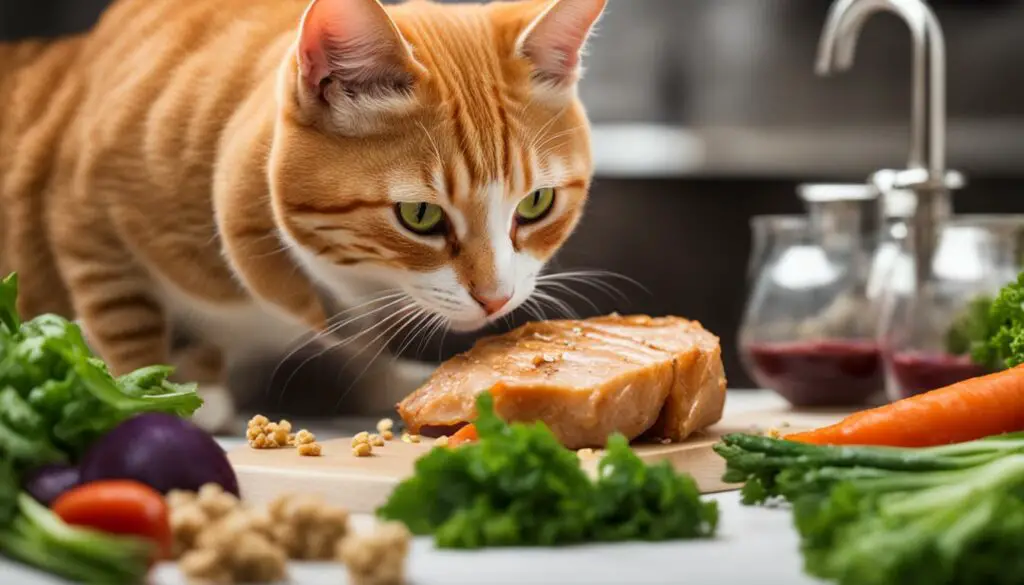
| Benefits of Consulting with a Veterinarian | Risks of Feeding Cats Chicken Breast |
|---|---|
|
|
Considering Your Cat’s Individual Needs
When it comes to feeding your cat chicken breast, it is important to take into account their individual needs. Cats, like humans, have unique dietary requirements based on factors such as age, weight, activity level, and any existing health conditions. Therefore, before incorporating chicken breast into their diet, it is crucial to evaluate whether it is safe and appropriate for your furry friend.
Some cats may have allergies or sensitivities to chicken, so it is essential to monitor their reaction when introducing it to their diet. Look for any signs of digestive upset or adverse reactions. It is always a good idea to consult with a veterinarian before making any changes to your cat’s diet. They can provide personalized recommendations based on your cat’s specific needs and health conditions.
Additionally, while chicken breast can be a healthy addition to your cat’s diet, it should not replace a balanced and complete cat food. Cats require a variety of proteins, carbohydrates, fats, vitamins, and minerals to maintain optimal health. Chicken breast can provide a valuable source of lean protein, but it should be part of a well-rounded diet that meets all of your cat’s nutritional needs.
Providing a Balanced Diet
When considering chicken breast for your cat, it’s important to remember that balance is key. A balanced diet for cats includes a combination of proteins, carbohydrates, fats, vitamins, and minerals in the appropriate proportions. While chicken breast can provide valuable nutrients, it should be part of a larger dietary plan that includes other protein sources.
Incorporating a variety of proteins, such as fish, beef, and eggs, ensures that your cat receives a diverse array of essential amino acids. Similarly, including carbohydrates from sources like rice or potatoes and healthy fats from sources like fish oil or flaxseed oil helps meet your cat’s energy needs and supports overall health.
| Protein Sources | Carbohydrate Sources | Fat Sources |
|---|---|---|
| Chicken Breast | Rice | Fish Oil |
| Fish | Potatoes | Flaxseed Oil |
| Beef | Sweet Potatoes | Chicken Fat |
By providing a well-balanced diet that incorporates various protein sources, carbohydrates, and fats, you can help ensure your cat receives all the necessary nutrients for optimal health and well-being.
Introducing Chicken Breast to Your Cat’s Diet
When it comes to incorporating chicken breast into your cat’s diet, it’s essential to do so gradually and carefully. Cats can be sensitive to dietary changes, so it’s important to monitor their response and make adjustments as needed. Here are some tips for introducing chicken breast to your cat’s diet:
Start with small amounts:
Begin by offering a small piece of cooked, boneless chicken breast to your cat. Allow them to sniff and taste it, observing their reaction. If they show interest and tolerate it well, you can gradually increase the portion size over time. Remember to provide a balanced diet overall, incorporating other protein sources and essential nutrients.
Observe for any adverse reactions:
Keep a close eye on your cat after introducing chicken breast to their diet. Watch for any signs of digestive upset, such as vomiting or diarrhea. Also, monitor for any changes in behavior, including decreased appetite or increased lethargy. If you notice any concerning symptoms, consult with your veterinarian for further guidance.
Vary the cooking methods:
Consider offering chicken breast cooked in different ways to add variety to your cat’s diet. You can try baking, boiling, or even grilling the chicken breast (without any seasoning or spices). Cats have individual preferences, so experimenting with different cooking methods can help keep mealtime exciting for them.
Remember, while chicken breast can be a nutritious addition to your cat’s diet, it should not replace a balanced and complete cat food. Consult with your veterinarian to ensure your cat’s specific nutritional needs are being met. By introducing chicken breast responsibly and in moderation, you can provide your cat with a tasty and nutritious treat while maintaining their overall health and well-being.
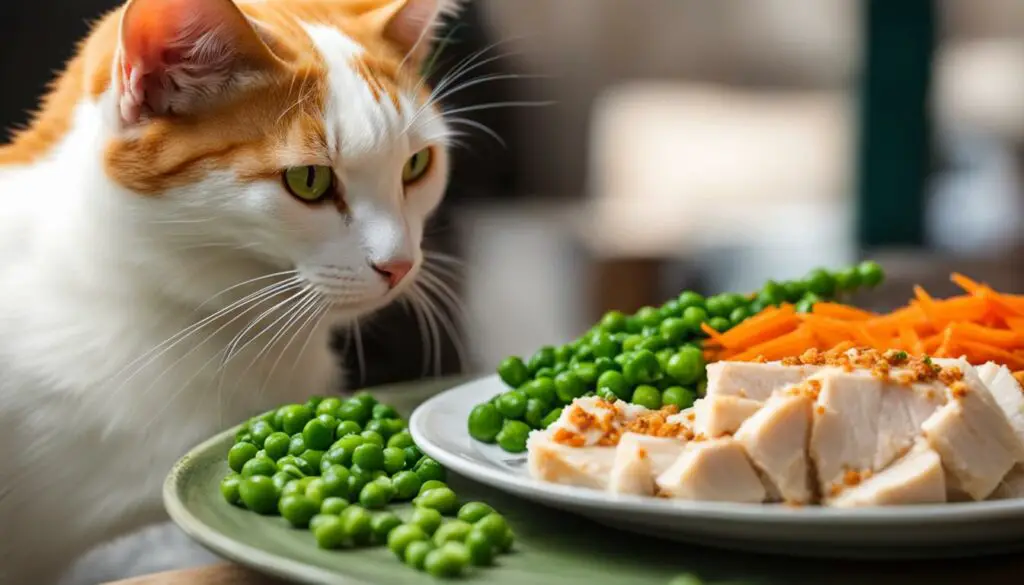
Monitoring Your Cat’s Health and Well-being
When feeding your cat chicken breast, it is crucial to monitor their overall health and well-being. Keep an eye out for any changes in their appetite, stool quality, or behavior, as these can be indicators of potential issues. Regularly observing your cat’s health allows you to address any concerns promptly and ensure they continue to thrive.
Signs to Watch Out For
- Changes in appetite: If your cat starts refusing food or shows a sudden increase or decrease in appetite, it may be a sign of an underlying health problem.
- Stool abnormalities: Monitor your cat’s litter box for changes in stool consistency or frequency. Diarrhea, constipation, or the presence of blood or mucus can all be signs of digestive issues.
- Behavioral changes: Keep an eye on your cat’s behavior and mood. Unusual lethargy, excessive grooming, aggression, or hiding may suggest that something is amiss.
- Weight fluctuations: Regularly weigh your cat to ensure they maintain a healthy weight. Significant weight loss or gain could indicate an underlying health condition.
If you notice any of these signs or any other unusual behaviors, it is important to consult with your veterinarian. They will be able to assess your cat’s health and provide appropriate advice or treatment if necessary.
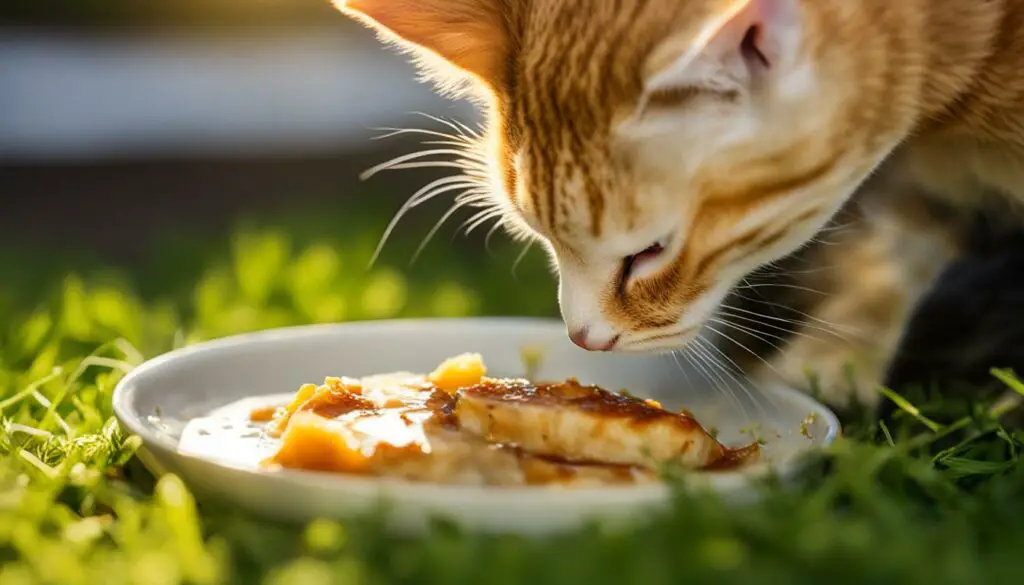
Regular Veterinary Check-ups
In addition to monitoring your cat at home, regular veterinary check-ups are essential for their well-being. Your veterinarian can perform a thorough examination, assess any changes in your cat’s health, and recommend any necessary preventive measures or treatments. These check-ups allow for early detection of health issues and ensure your cat receives appropriate care.
A Balanced and Varied Diet
While chicken breast can be a nutritious addition to your cat’s diet, it should not be the sole source of their nutrition. Cats require a balanced and varied diet to meet all their nutritional needs. Consult with your veterinarian to create a diet plan that includes a mix of protein sources, essential vitamins, and minerals. A varied diet helps prevent nutrient deficiencies and promotes optimal health and well-being for your feline companion.
| Signs to Watch Out For | Regular Veterinary Check-ups | A Balanced and Varied Diet |
|---|---|---|
| Changes in appetite | Early detection of health issues | Mix of protein sources |
| Stool abnormalities | Thorough examination | Essential vitamins and minerals |
| Behavioral changes | Preventive measures | Prevention of nutrient deficiencies |
| Weight fluctuations | Appropriate care | Promotion of optimal health |
The Importance of a Balanced Diet
Feeding cats chicken breast can be a beneficial addition to their diet, but it should not replace a balanced and complete cat food. Cats have specific nutritional needs that require a diverse range of nutrients, vitamins, and minerals. While chicken breast provides a high-quality source of lean protein, it is essential to offer a variety of protein sources to ensure all nutritional requirements are met.
Table: Comparison of Nutritional Content in Chicken Breast and Other Protein Sources
| Protein Source | Protein Content (per 100g) | Fat Content (per 100g) | Vitamin and Mineral Profile |
|---|---|---|---|
| Chicken Breast | 31g | 3.6g | Rich in taurine, vitamin B6, phosphorus, and selenium |
| Salmon | 20g | 13g | High in omega-3 fatty acids, vitamin D, and vitamin B12 |
| Beef | 26g | 17g | Good source of iron, zinc, and vitamin B12 |
| Turkey | 30g | 1.2g | Rich in selenium, vitamin B3, and vitamin B6 |
By providing a balanced diet that includes a variety of protein sources, you can ensure your cat receives all the necessary nutrients for optimal health. Consulting with a veterinarian can help you create a personalized diet plan that meets your cat’s specific needs.
In addition to protein, cats also require a balanced mix of carbohydrates and fats. It’s important to choose cat food that is specifically formulated to meet their nutritional needs. Look for brands that prioritize animal-based protein sources and avoid artificial additives or fillers.
The Role of Taurine in a Cat’s Diet
Taurine is an essential amino acid for cats and is found in high concentrations in meat, including chicken breast. It plays a crucial role in maintaining normal heart function, vision, and reproductive health in cats. A diet deficient in taurine can lead to serious health issues such as heart disease and vision problems.
Table: Taurine Content in Common Protein Sources
| Protein Source | Taurine Content (per 100g) |
|---|---|
| Chicken Breast | 1500mg |
| Beef | 1100mg |
| Turkey | 970mg |
| Salmon | 700mg |
As cats cannot produce taurine on their own, it is crucial to include taurine-rich foods like chicken breast in their diet. However, it’s important to note that excessive amounts of taurine can also be harmful. Consulting with a veterinarian will ensure your cat’s taurine needs are met without exceeding safe levels.
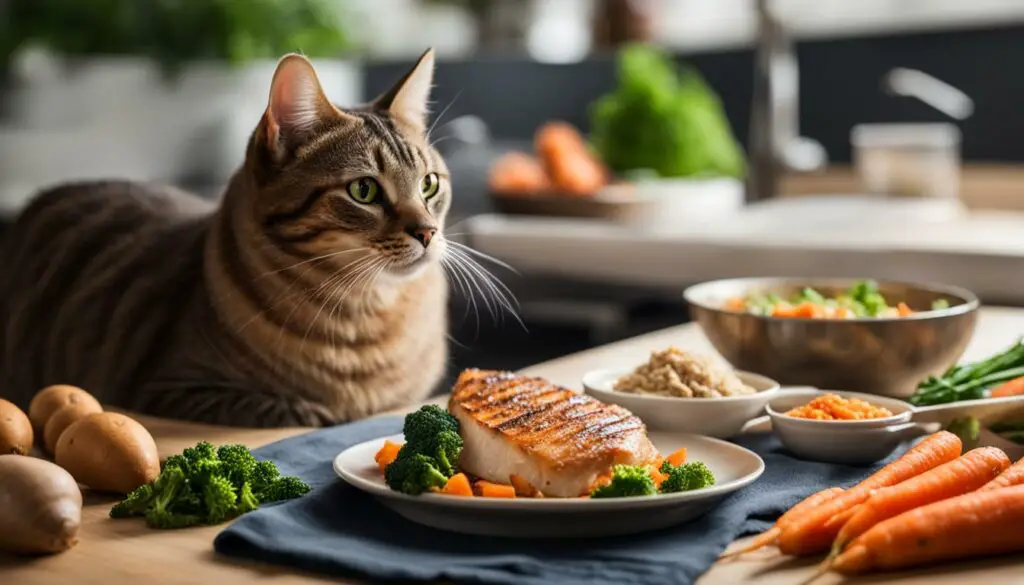
In conclusion, while chicken breast can be a healthy addition to a cat’s diet, it should not replace a balanced and complete cat food. Offering a diverse range of protein sources, along with appropriate carbohydrates and fats, is key to meeting your cat’s nutritional needs. Consult with a veterinarian to create a personalized diet plan that ensures your cat’s overall health and well-being.
Conclusion
In conclusion, the question of whether cats can eat chicken breast is a common concern among cat owners. While chicken breast can be a nutritious option for cats, it’s important to consider the individual needs and health conditions of your cat before incorporating it into their diet.
When feeding cats chicken breast, it’s crucial to follow safety measures and take precautions to minimize the risk of bacterial contamination. Whether cooked or raw, chicken breast should be handled and prepared properly to ensure the safety of your cat.
While chicken breast can provide essential nutrients and lean protein, it should not replace a balanced and complete cat food. Cats require a varied diet that meets their specific nutritional needs. Consulting with a veterinarian is always recommended to ensure your cat’s diet is appropriate and to address any concerns.
By considering your cat’s individual needs, introducing chicken breast gradually, and monitoring their health and well-being, you can make informed decisions about including this protein source in their diet. Remember, a balanced and appropriate diet is key to promoting your cat’s overall health and well-being.
FAQ
Can cats eat chicken breast?
Yes, cats can eat chicken breast in moderation as part of a balanced diet.
Is chicken breast safe for cats?
Chicken breast can be safe for cats if it is properly handled, cooked, and served without any seasoning or spices.
Can cats have chicken breast as their main food source?
No, chicken breast should not be the sole food source for cats. It should be part of a balanced diet that includes other protein sources and meets all of a cat’s nutritional requirements.
What are the benefits of feeding cats chicken breast?
Chicken breast provides a high-quality source of lean protein and essential amino acids, such as taurine, which are crucial for a cat’s overall health and well-being. It is also highly palatable for most cats.
What are the risks of feeding cats chicken breast?
The primary risk is the potential for bacterial contamination, such as Salmonella or E. Coli. Some cats may also have allergies or sensitivities to chicken.
How should I cook chicken breast for my cat?
You can cook chicken breast for your cat by boiling it in water or oven-baking it. It’s important to remove any seasoning or spices and cut the chicken into small, digestible pieces.
Is it safe to feed cats raw chicken?
Feeding cats raw chicken is a controversial topic. Raw meat can pose risks of parasite and bacterial contamination for both cats and humans. It’s important to handle raw chicken properly and take precautions to reduce the risk of contamination.
Can cats eat chicken bones?
No, it is not recommended to give cats chicken bones, whether cooked or raw. Cooked chicken bones can splinter and pose a choking hazard or cause injury to the cat’s gastrointestinal tract. Raw chicken bones can also lead to constipation or choking.
Are there commercial cat food options with chicken?
Yes, there are many commercial cat food options that contain chicken as an ingredient. Look for high-quality cat foods that provide balanced nutrition and meet your cat’s specific dietary needs.
Should I consult with a veterinarian before feeding my cat chicken breast?
Yes, it’s always a good idea to consult with a veterinarian before making any changes to your cat’s diet. They can provide personalized recommendations based on your cat’s specific needs and health conditions.
How should I introduce chicken breast to my cat’s diet?
Introduce chicken breast to your cat’s diet gradually, starting with small amounts and observing their response. If your cat tolerates it well, you can gradually increase the amount.
How do I monitor my cat’s health when feeding them chicken breast?
Watch for any changes in appetite, stool quality, or behavior. If you notice any concerning signs, consult with your veterinarian. Regular veterinary check-ups are also important to ensure your cat’s dietary needs are being met.
Should chicken breast replace a balanced cat food diet?
No, chicken breast should not replace a balanced and complete cat food diet. Cats require a variety of nutrients, vitamins, and minerals that a balanced diet provides.
Source Links
- https://www.purina.co.uk/articles/cats/feeding/what-cats-eat/can-cats-eat-raw-meat
- https://www.latimes.com/style/pets/la-hm-pets-cat-food-20170923-htmlstory.html
- https://blog.publicgoods.com/can-cats-eat-chicken/

